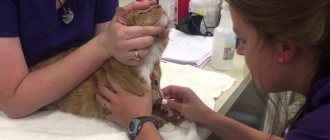Despite the fact that amyloidosis is a fairly rare cause of kidney dysfunction, it cannot be crossed off the list of possible diseases. According to statistics, it affects one person in 50-60 thousand, and the pathology can be disguised as glomerulonephritis or chronic pyelonephritis. The presence of amyloidosis is usually detected incidentally after excluding other renal diseases. In order to suspect it in a timely manner, you should carefully monitor the state of the body, especially in patients at risk.
What is amyloidosis?
The name of the disease comes from the word “amyloid” - this is a complex substance that is normally practically not produced in humans. It consists of a number of proteins and sugars and does not contain foreign particles (bacterial, viral, etc.). That is why our body does not react to it as a “threat to health” and does not eliminate excess amounts of this substance.
To date, it is not known exactly how and why amyloid production is activated. Scientists believe that the main role in this is played by genetic predisposition and disruption of the functioning of immune cells (plasmocytes), since they are responsible for the production of this substance.
Why is amyloid dangerous for the kidneys? Accumulating in an organ, it gradually destroys it and changes metabolism. This process proceeds very slowly and, at first, does not manifest itself in any way. However, as the kidneys are damaged, the body begins to retain water and a number of dangerous toxins (creatinine, urea, uric acid).
Is it possible to avoid: prevention
Since amyloidosis in the kidney area in cats is a consequence of a genetic predisposition, there are no specific preventive recommendations. It is important to provide your pet with quality care. It is necessary to feed him good food and feed in accordance with the breed, age and weight of the mustache. It is important to monitor the health status of your cat, and if atypical behavior appears, contact a veterinarian. If infectious diseases or other pathological disorders appear, then you should not try to cure your pet yourself. It is important to deworm your pet once a year, and if the cat goes outside for a walk, the procedure is performed every 3 months.
Causes
Currently, three types of disease are fundamentally distinguished, depending on the suspected cause:
- Primary amyloidosis – doctors attribute the main role in the occurrence of this form to heredity. It is believed that with certain changes in chromosomes (these are the microscopic structures that store our genetic information), immune cells can produce the abnormal protein needed to create amyloid;
- Secondary amyloidosis - the main cause of this type is the presence of another chronic disease in which the immune system is impaired;
- Senile - it is known that with age our body loses the ability to adequately perform some vital functions. The functioning of the immune system is one of them. In old age, the level of white blood cells remains at the same level, but their metabolism often changes. Because of this, pathological substances can be produced, including amyloid components.
Given these reasons, doctors have created “risk groups” among patients who are slightly more likely to develop kidney amyloidosis. These include:
- People whose relatives suffered from any form of this disease or kidney dysfunction due to an unclear cause;
- Patients over 65 years of age;
- Patients with rheumatoid arthritis, ankylosing spondylitis (ankylosing spondylitis), lupus, any malignant pathologies (cancer, sarcoma, leukemia, etc.).
If signs of kidney damage appear in these groups of patients, it is imperative to exclude amyloidosis as a possible cause of impaired renal function.
Consequences and clinical manifestations
What are the symptoms of amyloidosis in cats? Amyloid deposits in the kidney cause the organ to cease to perform its main physiological function associated with the formation of urine. Amyloid can also be deposited in the liver, spleen and pancreas, which also causes severe consequences for the entire body.
The accumulation of amyloid in the kidneys leads to the rapid development of renal failure. Symptoms of kidney failure include anorexia, lethargy, and rapid weight loss. Other clinical signs include polyuria and polydipsia, that is, excessive thirst and sharply increased volumes of urination. In some cases, episodes of spontaneous vomiting are recorded.
Renal amyloidosis in cats leads to the fact that the affected organ begins to release primary urine into the external environment, which is almost similar in composition to blood plasma. Simply put, along with secretions, a lot of valuable substances and protein leave the body. It is very dangerous that these include globulins that prevent blood clotting. Because of this, cats with amyloidosis are extremely susceptible to thrombosis of the veins and arteries. Most often, blood clots in this disease block the pulmonary arteries, and symptoms can range from severe shortness of breath to severe distress.
Symptoms of kidney amyloidosis
Since amyloid accumulates in organs gradually, this disease is characterized by a very slow course with a gradual increase in symptoms. On average, several decades pass from the appearance of the first signs of the disease to severe kidney damage. During this time, patients have time to be thoroughly examined and the true cause of the disease is identified, but, as a rule, it is too late for successful treatment.
First signs
Difficulties with timely diagnosis arise due to the latent course of the pathology in the first stages. The first symptom of renal amyloidosis does not bother the patient for a long time - the appearance of protein in the urine (synonym - proteinuria). In this case, the patient does not experience discomfort in the lumbar region, there is no swelling, and blood pressure remains normal.
Why is this condition dangerous? Minor protein losses in themselves do not have much significance for the body, but proteinuria indicates increasing kidney damage. Subsequently, this minor symptom will develop into a whole complex of disorders throughout the body.
This stage usually lasts 10-15 years. At this time, it can only be detected during a random medical examination with a urine test. That is why patients at risk are recommended to undergo a thorough examination at their place of residence (with their local doctor) once every 6-12 months.
Characteristic symptoms
Over time, a significant amount of amyloid accumulates in the organ, causing most of its functions to be impaired. The kidney filter is already severely damaged - it is not able to retain the substances necessary for the body, so about 3 grams of protein can be lost daily (normally, losses should not exceed 0.13 g/l). Patients also experience swelling of varying severity - from slight swelling of the face and hands to extensive sweating of fluid into all organs and tissues.
In addition to the above symptoms, patients with renal amyloidosis may also complain of:
- Frequent and copious urination - failure of the kidney filter can lead to significant fluid losses (up to 7-10 liters/day). Doctors call this condition “renal diabetes.” Despite this, swelling may persist due to the fact that fluid leaves the bloodstream and enters the tissues;
- Changes in blood pressure (BP) - the disease can occur both against a background of low blood pressure (less than 100/70 mmHg) and with hypertension (more than 140/90 mmHg). It is difficult to say which option the patient will have, but much more often renal amyloidosis is combined with hypotension. This depends on the nature of the organ damage, the degree of proteinuria and the condition of the patient’s body;
- Change in the color of urine - the appearance of a red tint of the liquid (figurative name - “the color of meat slop”) is another sign of damage to the kidney filter;
- Weight gain – this symptom can occur for two reasons. First of all, weight may increase due to fluid retention in edema. In addition, in kidney patients, lipid metabolism in the body is disrupted - the level of cholesterol, triglycerides and lipoproteins increases. These substances lead to the accumulation of fats in tissues (in particular, subcutaneous tissue).
In the scientific literature, doctors call this stage “amyloid-lipoid nephrosis.” It lasts, on average, about 6 years. It is very important that at this stage (or earlier) the correct diagnosis is made and treatment measures are initiated. Otherwise, the disease will very quickly move into the final irreversible stage.
Irreversible kidney changes
At this stage, the kidney tissue almost completely loses its functions. The filter not only allows a large amount of protein to pass through, but also retains various toxins in the body (creatinine, uric acid, urea, drug breakdown products, etc.). The symptoms listed above are accompanied by:
- Constant weakness;
- Poor attention, absent-mindedness;
- Constant headache with regular episodes of dizziness;
- In severe cases, disturbances of consciousness, up to stupor and even coma.
This condition is referred to as chronic renal failure. Its peculiarity with amyloidosis is that it almost always occurs against the background of low blood pressure and is accompanied by signs of damage to other organs (due to the deposition of amyloid in them).
| Organ/system damaged by amyloidosis | Characteristic symptoms |
| Leather |
|
| Heart |
|
| Digestive tract |
|
| Joints | Characterized by morning stiffness, which decreases after movement. |
| Nervous system | Decreased sensitivity in the feet and hands - the patient may not feel touch with a sharp, hot or cold object. The skin in these areas loses its elasticity, becomes dry, and peeling increases. It is also associated with damage to nerve pathways. |
The presence of one of the symptoms listed in the table, in combination with signs of kidney damage, is a reason to suspect amyloidosis.
Prevention of kidney disease in cats
Knowing how difficult and life-threatening kidney diseases are in cats, it is better to focus your efforts on their prevention and follow a number of recommendations from veterinarians:
- food for domestic cats must be adapted to their digestive system, that is, in no case should they be “pampered” with salty, sweet, fatty foods and smoked foods, as well as pasta and legumes. Sausage is also not for an animal's bowl,
- The water quality must also be controlled by the owner. As a rule, chlorinated water comes from the tap; it is detrimental to the entire genitourinary system of the cat. Replace the water with filtered water or at least leave it in containers for some time so that most of the chlorine evaporates from it,
- the kidneys can get cold, which will also provoke an inflammatory process. Therefore, try to avoid drafts and strong ventilation during the cold season.
- Just like hypothermia, overheating will have a negative impact on your pet. A furry friend in a hot room absorbs more water, putting a strain on his kidneys,
- and, of course, mobility and mobility again. Young cats rarely get kidney disease because they are more active. But as they age and gain weight, they can become lazy. This is where problems creep in. Stagnation of urine will begin and, as a result, kidney disease. Make your pet move and play more, this will protect him from many problems with the normal functioning of his entire body.
The cat owner must remember that kidney diseases are very insidious . Kidney disease can be chronic and not show itself for a long time. The pain will not bother your pet, and symptoms appear only after some time. Veterinarians strongly recommend paying attention to the appearance and behavior of a friend, especially one over 7 years of age.
In order not to miss the moment, upon the arrival of this period, it is necessary to undergo annual scheduled medical examinations of your domestic cat with the necessary tests and an ultrasound scan.
Diagnostics
As already mentioned, it is quite difficult to identify this disease in a timely manner. To do this, you need to carefully analyze all the patient’s complaints, assess the condition of not only the kidneys, but also other organs, and prescribe the necessary laboratory examination. In renal amyloidosis, changes can be found in the following tests:
| Laboratory analysis | Changes in amyloidosis |
| Clinical blood test (from finger) |
|
| Biochemical blood test (from a vein) | Level increase:
Decrease in the amount of total blood protein (due to its excretion in the urine) - less than 67 g/l. |
| Clinical urine analysis |
|
These studies are not enough to confirm the diagnosis. Currently, there are two methods by which you can reliably verify the presence of the disease:
- Subcutaneous tissue puncture - if amyloid is deposited in internal organs, there is a high probability that it is present in fatty tissue. To detect it, a small part of this tissue is taken from the patient with a syringe with a wide needle. It is stained using a special technique and examined under a microscope. Detection of a pathological protein, in combination with renal disorders, makes it possible to verify the correctness of the diagnosis;
- Kidney puncture - the procedure is carried out in a similar way, only the material is taken directly from the organ.
Other diagnostic methods, such as renal ultrasound, CT or MRI, do not assess the presence of amyloid and determine the cause of the damage.
Treatment of renal amyloidosis
It is important to note that this pathology is difficult to treat. It is impossible to completely remove amyloid from the kidney using any medications, physiotherapeutic procedures or traditional treatment methods. However, with the help of timely therapy, it is possible to significantly reduce the activity of the disease and prevent irreversible kidney damage.
Diet
One of the most important components of treating renal amyloidosis is proper nutrition. To reduce the amount of amyloid produced and reduce the load on the filtration barrier, you need to limit the following in your diet:
- Table salt - you can add this seasoning during cooking, but you should not subsequently add salt to already cooked food. You should also refrain from eating lightly salted/salted canned food (fish, cucumbers, mushrooms, etc.);
- Casein, which is contained in any dairy products (cheese, cottage cheese, sour cream, milk, etc.) and special mixtures for bodybuilders;
- Veal, beef.
The diet can include any cereals (especially barley and pearl barley), vegetables, lamb and chicken. The consumption of flour products should be limited to patients with excess body weight, as they can become “donors” of cholesterol and triglycerides.
Drug therapy
Currently, mainly three drugs are used to treat renal amyloidosis:
| A drug | Operating principle | Typical side effects |
| Unithiol | This medicine binds certain groups of proteins from which amyloid is synthesized. Thanks to this, the course of the disease is significantly slowed down and partially stabilized. |
|
| Dimethyl sulfoxide (synonym – Dimexide) | The exact mechanism of action on this disease is not known, but it has been reliably confirmed that after a course of the drug, patients experience improvement. |
|
| Delagil/Plaquenil | The drugs reduce the production of amyloid by inhibiting the synthesis of certain enzymes. Effective only for treating the initial stages of the disease. |
|
It should be said that a strict algorithm for the treatment of renal amyloidosis has not been developed, so an experienced doctor independently adjusts the therapy, depending on the activity of the process and the patient’s well-being.
Kidney transplant
Such a radical method is resorted to only in case of irreversible kidney damage, when the question is about the life and death of the patient. Unfortunately, in Russia, organ donation is one of the most problematic issues in terms of legislation. Therefore, the chances of receiving a kidney compatible with a particular patient, at the right time and in a specially equipped operating room with transplant doctors, are quite small.
Factors influencing the development of kidney disease in cats
Many factors influence the functioning of the excretory organs.
The unfavorable ones include the following:
- Unsatisfactory nutrition: protein overfeeding, imbalance in vitamins and minerals, consumption of food unusual for cats, containing spices, sugar, table salt, and also smoked or fried.
- Unfavorable living conditions: drafts, dampness, dirty tray.
- Viral and bacterial infections.
- Chronic diseases: cystitis, urolithiasis, pancreatitis; hepatitis, diabetes mellitus, gingivitis, pyometra.
- Poisoning with toxic substances or medications.
- Worm infestation.
- Allergy.
- Poor water quality.
- Genetic abnormalities. They end up dying at an early age.
- Predisposition to kidney disease in certain breeds.
Forecast
When the disease is detected in the early stages and treated adequately, it is often possible to slow down the process so much that it slowly and gradually develops over 30-40 years. Throughout life, the patient may experience discomfort due to periodic symptoms of organ damage, but their quality of life suffers only slightly.
As a rule, patients die from renal amyloidosis only when irreversible changes develop. They can occur with late detection of the disease and a rapidly progressing process.
What affects diseases: causes
According to veterinarians, the main source of impaired kidney function in kittens and adult animals is an unbalanced diet and insufficient care from the owners.
In most cases, symptoms of inflammation are detected in pets after 7 years of age, when age-related changes occur in the body. There are other reasons why the kidneys hurt and the process of urine excretion in cats is disrupted:
- diseases that provoked various infections;
- negative reaction to various allergens;
- intake of toxic substances from food, due to which one kidney or both organs cease to function normally;
- mechanical kidney damage;
- entry into the body of helminths and other parasites;
- genetic factor;
- diseases of the gastrointestinal tract;
- abundant intake of meat and fish, especially fatty varieties;
- problems with weight, in the direction of excessive increase or sharp decrease;
- insufficient fluid intake into the cat’s body;
- highly salty or sweet foods;
- lack of activity of the pet;
- hypothermia of the urinary system;
- urine retention.
FAQ
Is colchicine effective for treating amyloidosis?
Currently, colchicine is used quite rarely, due to its pronounced side effects. However, the effectiveness of this drug has been confirmed by clinical trials and empirical experience, so the question of prescribing is decided individually by the treating doctor.
What is the likelihood of passing on amyloidosis to your child?
There is such a possibility, it is especially high if this is not the first case of the disease in your family. To reduce it, it is necessary to carry out preconception preparation before conception and reduce the activity of the process as much as possible.
How to prevent the development of renal amyloidosis?
No measures have been developed to prevent this disease.
Treatment of kidney diseases
When symptoms indicate kidney disease in cats, treatment is prescribed.
Treatment of a cat in the clinic
The following activities are carried out:
- eliminate the underlying and concomitant diseases;
- use medications (subcutaneously, intravenously);
- give a course of antibiotics when there are infections;
- use fluid therapy when dehydration is observed;
- use physiotherapeutic methods;
- follow nutritional rules;
- They are treated with traditional methods, herbal infusions (mint, lemon balm, St. John's wort, oregano).











